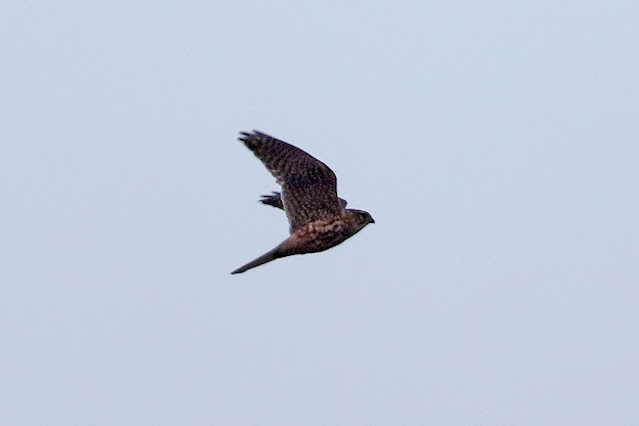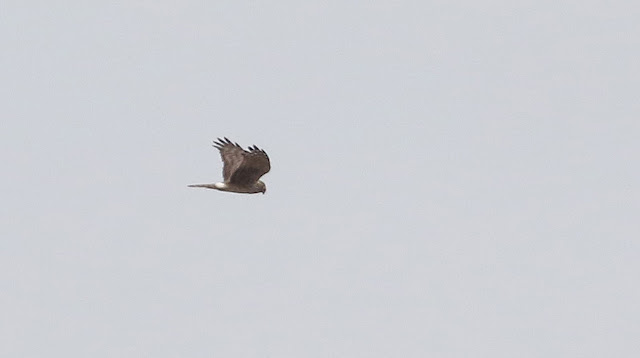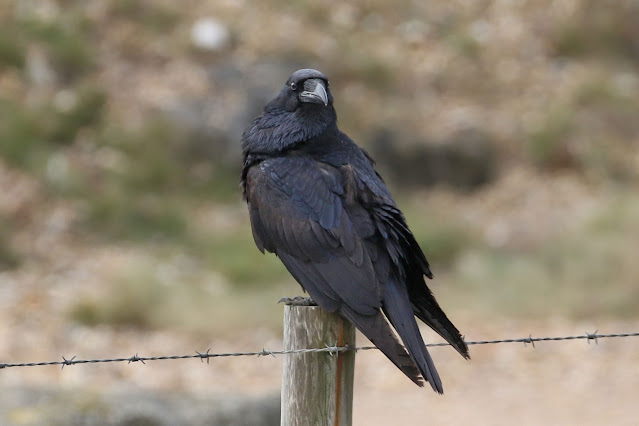I arrived at the lay by on Roger Penny Way at about the same time as last week, but it was a little brighter, the sun rise having moved on by about fifteen minutes. Ian arrived shortly after me, freshly returned from his exploits in Costa Rica, it was back to the grind of Hampshire birding. We were back in the Forest to see if we could get the ultimate image of the male Hen Harrier, my patience ran out last week and while I managed to see it, it could have been better.
We headed down the slope, this time not requiring the torch, and crossed the stream at the bottom and then headed up the hill towards the gorse. Across the bracken the Song Thrush was singing and there was also the call of a Chaffinch. It was a case of at what time would the harrier leave the roost, last week it was about 35 minutes after sun rise, but it was far gloomy then with a much heavier cloud cover, today it was definitely brighter. A pair of Mistle Thrush called from the bushes close by and then were seen heading au the slope towards the open grass of Leaden Hall.
As the designated time for sun rise approached a group of about a dozen crows started calling on the ridge and a bird of prey appeared being mobbed by the crows, it turned out to be a Buzzard and was chased across the valley by the crows. A Raven called from across the valley and we watched a couple interacting or chasing the crows. Ian then picked up a falcon coming towards us from the west. We both thought it was a Peregrine at first , but as it came towards it was clear that it was a Merlin, a large female.
The name “Merlin”
comes from esmerillon, the old French name for the species. Merlins used
to be called “pigeon hawks” because in flight they look somewhat pigeon-like.
Their species name, columbarius, is also a reference to pigeons. Although the merlin shares its name with the legendary
wizard Merlin from the Arthurian legends, the bird is not named after
the wizard.
The male Merlin is quite distinctive and has a blue-grey
back. Its underparts are buff- to orange-tinted and heavily streaked with
black to reddish brown. The female which we were watching is brownish-grey to
dark brown above, and whitish buff spotted with brown below. Besides a weak
whitish supercilium and the faint dark malar stripe—which
are barely recognizable in both the palest and the darkest birds—the face of
the Merlin is less strongly patterned than in most other falcons.
As with most raptors, female Merlins are larger than males,
which was one reason for the confusion with identification, the other being we
are never lucky with Merlin sightings and went for the default!.
The Merlin headed up the valley towards the harrier roost site and we wondered if it might flush out something, but all went quiet again. Then Ian picked up another raptor, again coming from the ridge to the west and flying across the valley. This time it was a ring-tail Hen Harrier.
While the male is mainly grey above and white below with a
white rump and grey wings with black wing tips, the female is brown above with
white upper tail coverts, hence females, and the similar juveniles, are often
called "ringtails". Their underparts are buff streaked with brown. Immatures look like females but with less
distinct barring, dark brown secondaries dark brown and less-streaked belly
This is a typical harrier, which hunts on long wings held in
a shallow V in its low flight during which the bird closely hugs the contours
of the land below it. Hen harriers hunt primarily small mammals, as do
most harriers. Up to 95% of the diet comprises small mammals. However, birds are
also hunted with some regularity, especially by males.
Having crossed the valley it turned to follow the stream, again, like the Merlin, towards the known roost site of the male Hen Harrier.
The term "Hen Harrier" refers to its former habit
of preying on free-ranging fowl, and it is this liking for prey such as
pheasant and grouse young that has brought the Hen Harrier into conflict with
the shooting fraternity, game keepers being protective of there grouse moors
persecuting the unfortunate Hen Harrier on their breeding grounds
It drifted up the valley and away, not the bird we had hoped for, but for me it was a different one to that I had seen the previous week. We waited for a little while longer, but eventually realised that maybe they had changed their roost, however we crossed the heather and bracken towards the famous birch tree. From the side of the valley there was a different perspective on Black Gutter bottom.

Distances are difficult to gauge in the valley. At times the tree looks so far away as it sits on the horizon, but as I headed towards it I realised it wasn't really that far away. On almost every visit to Black Gutter Bottom and Leaden Hall this tree cries out for different ways to photograph it, the remoteness of the tree amongst the heather a symbol of the wilderness that this area has and that of the Forest. The last
photographs were taken back in October last year
Ian was behind me and took these photographs, this one as I contemplated the significance.
and this one in full celebration
From the tree we scrambled back down the slope to the stream where we crossed the stream. No bird life was flushed in the area so it would seem the harriers chose a different roost site on Friday evening
Back at the car we decided to move on to Hurst Spit. While Ian had been away I had seen the Shore Lark that has become resident there. At the time, two weeks ago he hoped that it would stay and as it was still about we decided to see if we could find it today. With the number now going to see it the challenge would be finding it, but after the experience two weeks ago I had a good idea of where to look.
We parked amongst the RVs along New lane, an area that is becoming a bit like a scene from Nomadland the movie. I had been aware of a Raven that has become quite tame around the Cut Bridge, clearly taking advantage of the food given to the Mute Swans, however it was sat in the middle of the field when I visited two weeks ago. As we approached the bridge the Raven was sitting on the railing but dropped to the rocks below. It was completely unconcerned by us as we walked up to it, allowing us to get as close as a just over a metre. It was a unique opportunity to photograph a quite majestic bird close up.
A Raven is any of several larger-bodied bird species
of the genus Corvus. These species do not form a single taxonomic
group within the genus. There is no consistent distinction between "crows"
and "Ravens", common names which are assigned to different species
chiefly based on their size.
The largest raven species are this one, the Common Raven and
the Thick-billed Raven. The term
"Raven" originally referred to the common raven (Corvus
corax), the type species of the genus Corvus, which has a larger
distribution than any other species of Corvus, ranging over much of
the Northern Hemisphere.
Not just a large crow, the Raven is massive, with a thick neck, shaggy throat
feathers, and a Bowie knife of a beak. In flight, ravens have long,
wedge-shaped tails. They're more slender than crows, with longer, narrower
wings, and longer, thinner “fingers” at the wingtips.
The raven is an intelligent bird with a large
and varied vocabulary, including guttural croaks, gurglings, and a sharp metallic
“tok.” This birds as we photographed it continued to call.
Studies have shown that the common raven is capable of
saving items of value that can be used later as tools or
as goods for barter, behaviour that strongly suggests that this bird has the
ability to plan for a future when these items might be needed. This bird had clearly worked out that man was not a threat here, but an opportunity to be exploited.
Looking extremely majestic here, almost Knight like with the shaggy throat feathers.
The background here are the Mute Swans gathering on the stream.
Once widespread, ravens were driven to the west and north of
Britain, persecuted by gamekeepers and farmers. In the late eighties the only
place I could see a Raven was the moors of Devon and Cornwall, West Wales and
Scotland. Following many years of legal
protection ravens are now spreading eastwards to inhabit former haunts and have
become a lot more common around Hampshire and the south coast.
If there is any doubt regarding the identification of a Raven over a crow on the ground it is the massive bill that clinches the identification.
Enlarged you can just make out the reflection of Ian and I in the Raven's eye.
Pulling ourselves away from what was a unique experience we headed out along the bottom of the Spit. The tide was low just after sunrise so was now starting to rise. Waders, mostly Dunlin gathered along the waters edge, while out on the water was a male Red-breasted Merganser, probably the same bird present two weeks ago, its crest though not so "punky" today.
It was diving frequently.
A Greenshank flew across the channel calling and settled in the shallow water.
It went through some bobbing to start with before settling down to roost.
A few Dunlin were close in feeding at the water's edge.
In amongst them was a Grey Plover.
The biggest surprise though was a pair of Ruff, the surprise being the presence of the white plumaged bird. I had last seen this one on Fishtail where I assumed it would most likely be found. It was interesting that it would range across the marshes and be seen here.
The two Ruff along with a headless Black-headed Gull. I am assuming that these are a pair, the white, larger bird being the female.
Here the white bird on its own.
I set off along the bottom of the spit, but decided for a stupid reason to scramble up the bank. After recovering I ten decided it would be better if I walked along the bottom to try and flush anything and Ian watch from the top.
I wanted to get the reflection of the moored yacht on the last visit, so ensured I didn't miss out today.
The channel follows the Spit for about half a mile then turns to the east. This was where the Shore Lark was found when I was here last time so I was hoping it would do the same again. I was carrying a scope and would stop every so often to scan the marsh on the far side without any luck.
On reaching the bend there were one or two Turnstone and Dunlin flushed from the water's edge. As I moved on I noticed a small bird move and my first thought was maybe Rock Pipit. I stopped checked and yes it was the Shore Lark, I turned, called to Ian who at first didn't react, but on the second shout he rushed forward and thankfully got on it.
It moved from the green covered sand to the bladder wrack a favourite location from the last time.
It seemed quite comfortable here and this allowed those at the top of the spit the opportunity to photograph relatively closely.
You can just make out the "horns" slightly showing on the head in this view.
Then it flew to the longer grass a little further away. I decided then to scramble up the side of the Spit once more and this time was worse than the last, I was exhausted when I reached the top but I managed to get some more images as the Shore Lark sat up on a small piece of drift wood.
Then it headed off into the grass and became harder to follow and eventually see. We stood and waited hopeful that it might appear. I left the call to Ian and we eventually decided to walk back towards the bridge, we were going to check the rocks along the beach for a Purple Sandpiper.
First I went back to the car to drop off the scope and opposite on one of the fence posts was the Raven.
This time from the other side.
A pair of Stonechat could be seen feeding from the fence wire.
We walked as far as the Lighthouse cafe where we checked the rocks for the sandpiper, but could only find a Rock Pipit. Walking back past Sturt Pond there was at least two hundred Brent Geese and a single Black-tailed Godwit.
At the bridge one of the male Mute Swans was displaying and against the dark water this made for some very nice portrait opportunities.
Following lunch we decided to move on the short distance to Keyhaven, which will be the topic of the next post.












.jpg)






































No comments:
Post a Comment